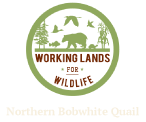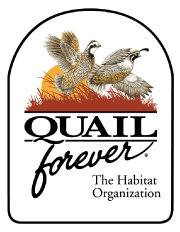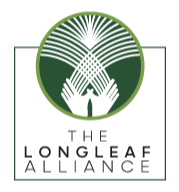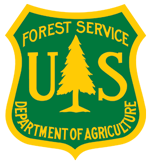Images
Golden-winged Warbler
These birds spend much of their time in young forests and old field succession environments.
Indiana Bat
The Indiana bat is an endangered species that is found over most of the eastern half of the United States.
Eastern_Brook_Trout
The Eastern Brook Trout is the only native trout that inhabits the cold, clear streams of the eastern United States. It is the state fish in many eastern states and is a prized sport fish by anglers.
Salamander
There are more species of Salamanders in the Appalachians, include endemics, than anywhere else on the planet.
Mussels
Due to their long lifespan and sensitivity to degradation, freshwater mussels are increasingly valued for tracking status and trends of the health of inland waters.
Wood Thrush_02
Wood Thrush breeds in the deciduous forests of eastern North America. They are experiencing population declines due to degradation of habitat.
Cerulean Warbler
This sky blue Warbler inhabits large blocks of mature deciduous forest in the Appalachians. They prefer environments with more open canopies and gaps that allow sunlight to reach the forest floor.
Wood Thrush
Wood Thrush breeds in the deciduous forests of eastern North America. They are experiencing population declines due to degradation of habitat.
Appalachian Trail Lookout, Virginia
View of farmland and forests from a lookout point along the Appalachian Trail in Virginia
Appalachian Trail Lookout, Virginia
View of Farms and Forests from lookout point on the Appalachian Trail.
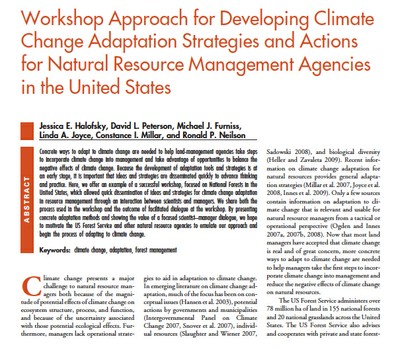
Workshop Approach for Developing Climate Change Adaptation Strategies and Actions for Natural Resource Management Agencies in the United States
Workshop Approach for Developing Climate Change Adaptation Strategies and Actions for Natural Resource Management Agencies in the United States Image

Scarlet Indian paintbrush (Castilleja coccinea)
scarlet Indian paintbrush_squamatologist_2010_Macon Co. NC.jpg

Frasers sedge (Cymophyllus fraserianus)
Frasers sedge_Jason Hollinger_2011_Great Smoky Mountains, TN.jpg
Marcellus Shale Wells within Region
Map showing the permitted Marcellus Shale wells within the Appalachian LCC area.
Marcellus Shale Wells within Region
Map showing the permitted Marcellus Shale wells within the Appalachian LCC area.
Riparian Restoration Figure 1
Riparian corridor areas in Virginia that are high priority (black = upper quartile of solar gain and less than 70% canopy cover) for riparian restoration to mitigate water temperature increases. Brook trout priority areas are defined by elevation gradients (0-300 m low priority; 300 – 600m average priority; > 600m high priority). Cross hatched polygons represent existing brook trout habitats. Blue and green elevation gradients represent potential cold water brook trout habitat.
Riparian Restoration Figure 1
Riparian corridor areas in Virginia that are high priority (black = upper quartile of solar gain and less than 70% canopy cover) for riparian restoration to mitigate water temperature increases. Brook trout priority areas are defined by elevation gradients (0-300 m low priority; 300 – 600m average priority; > 600m high priority). Cross hatched polygons represent existing brook trout habitats. Blue and green elevation gradients represent potential cold water brook trout habitat.

Filezilla.jpg
Screenshot of FileZilla's opening window. The area that we will using the most is enclosed in the red box:
App LCC Potential Karstic Carbonate Rocks
Karst is a landscape produced by dissolution of rocks and the development of subterranean drainages dominated by the flow of ground water in enlarged conduits. Karst landscapes typically include cave entrances, sinkholes, losing streams, springs, and large and small-scale features on bedrock surfaces.
Connecticut River Watershed Pilot Core Team
On September 26th, 2014, the Core Team gathered in Hadley, Mass., to review progress and discuss next steps in realizing a conservation design vision for the watershed and region.

Large-leaf grass-of-Parnassus (Parnassia grandiflora)
large-leaf grass-of-Parnassus_Eleanor_2013.jpg

Image of Energy Mapping Forecast Tool
Mapping tool displays intersection between high probability energy development and forest cover.

Wind Turbine Energy Development Probability
Map showing existing wind turbines with the probability that a given area will be developed indicated by color (dark red is high probability; dark blue is low).

Forest importance to water supply
The US Forest Service’s Forests to Faucets Project represents one approach to ecosystem service assessment. Watersheds are ranked in terms of both forest cover and the estimated number of people who rely on them for drinking water. This highlights the water filtration services that forests provide in different landscapes.

Appalachian Landscape Conservation Cooperative geographic extent
The Appalachian Landscape Conservation Cooperative serves a vast region, including parts of 15 eastern US states. Landscapes and the ecosystem services they provide within this region are highly diverse and vary from place to place.
Mixed spruce-fir and northern hardwood forest
Mixed spruce-fir and northern hardwood forest on the upper western slope of Waterrock Knob (el. 6,292ft/1,918m) in the Plott Balsams of Western North Carolina, USA. This view is from a cliff just off the Waterrock Knob Trail. The dead trees are Fraser firs killed by the balsam woolly adelgid.
A student collecting stream insects
Each year the Toes in the Toe Watershed Discovery event brings 5th-grade students from North Carolina’s Yancey and Mitchell Counties out to a river in their community. On the banks of the river they rotate through a variety of educational stations focused on stream health and the importance of river. Stations include art, farming, energy, fish, and stream macroinvertebrates.Because the watershed is home to the endangered Appalachian elktoe mussel, the Fish & Wildlife Service helped create the event and continues to help students explore the North and South Toe rivers in search of stream insects, mollusks, and other animals.
Mixed spruce-fir and northern hardwood forest
Mixed spruce-fir and northern hardwood forest on the upper western slope of Waterrock Knob (el. 6,292ft/1,918m) in the Plott Balsams of Western North Carolina, USA. This view is from a cliff just off the Waterrock Knob Trail. The dead trees are Fraser firs killed by the balsam woolly adelgid.
A student collecting stream insects
Each year the Toes in the Toe Watershed Discovery event brings 5th-grade students from North Carolina’s Yancey and Mitchell Counties out to a river in their community. On the banks of the river they rotate through a variety of educational stations focused on stream health and the importance of river. Stations include art, farming, energy, fish, and stream macroinvertebrates.Because the watershed is home to the endangered Appalachian elktoe mussel, the Fish & Wildlife Service helped create the event and continues to help students explore the North and South Toe rivers in search of stream insects, mollusks, and other animals.
Hemlock Wooly Adelgid
By Nicholas A. Tonelli from Pennsylvania, USA (Henry's Woods (6)) [CC BY 2.0 (http://creativecommons.org/licenses/by/2.0)], via Wikimedia Commons
Wildfires in Eastern U.S.
By Glenn Research Center (https://www.dvidshub.net/image/857727) [Public domain], via Wikimedia Commons

Forest above-ground biomass
The Woods Hole Research Center’s National Biomass and Carbon Stock Dataset for the year 2000 represents an important component of carbon sequestration by Appalachian forests. The spatial distribution of this ecosystem service is influenced over time by drivers such as surface mining, urbanization, climate change, and forest growth.
Figure 1. Conceptual diagram depicting the hydraulic fracturing process
from: Brian Buchanan et al., 2015
Appalachian Farm
Landscapes in the Appalachians supply clean water, productive soils, and many other natural resources which in turn support a wide variety of ecosystem services. These services are relied upon not only by people living in the region, but also by millions of people far removed these landscapes.
Appalachian LCC Subregions
Division of the Appalachian LCC into ecologically consistent subregions used for climate change vulnerability assessments
January 2012 Expert Panel Meeting, NatureServe Home Office
Expert Panel discussing a decision tree to aid in selecting vulnerability assessment methods. Panel members (from left to right): Kim Hall, The Nature Conservancy, Great Lakes; Robert Cooper, University of Georgia; Bruce Young, NatureServe; Jean Brennan, Appalachian LCC; Kyle Barrett, Clemson University; Healy Hamilton, Marine Conservation Institute (now of NatureServe); not shown: John O'Leary, Massachusetts Department of Fish and Wildlife; Hector Galbraith, National Wildlife Federation; Patricia Butler, Michigan Technical University, Northern Institute of Applied Climate Science; Lesley Sneddon, NatureServe
Cave Count per 20km Grid Cell
Total number of caves within a 20 kilometer grid cell. Each cell represents a range of caves found within that area.
Study Area Carbonate Bedrock Exposure Map
This map depicts the carbonate bedrock exposure within the study area.
Aquatic Records
The karst map provides the basic template for analyzing the distribution of cave species. Almost without exception, all caves occur within the karst areas. There were a few records of cave-dwelling species from outside karst areas (mostly springs) but the data was trimmed to fit within the karst areas, with a 1 km buffer to allow for errors in georeferencing). This map displays the aquatic records within karst areas in the Appalachian region.
Terrestrial Records
The karst map provides the basic template for analyzing the distribution of cave species. Almost without exception, all caves occur within the karst areas. There were a few records of cave-dwelling species from outside karst areas (mostly springs) but the data was trimmed to fit within the karst areas, with a 1 km buffer to allow for errors in georeferencing). This map displays the aquatic records within karst areas in the Appalachian region.
Percentage of Karst Area within Grid Cell
Each cell represents the percent of karst within a 20 x 20 kilometer grid cell, a measure of habitat quantity. This attribute can be used to predict presence/absence of particular ecological groups in caves.
Cave Species Richness Hotspots
Caves with the most aquatic and terrestrial species. The number of species is highly dependent on sampling intensity, including the number of sampling trips.
Carbonate/Non-carbonate Contact Linear Sum
Cumulative lengths of contacts between karst and non-karst, measuring both patchiness of available habitat and perhaps dispersal corridors if cave passages are differentially developed along these contacts. This information can be used to predict presence/absence of particular ecological groups in caves.
Stygobiont and Troglobiont Endemics by Cave
Total number of stygobiont and troglobiont endemic species within a cave.
Single Grid Cell Endemics
Many aquatic and terrestrial species are geographically rare, often found in a single cave. This map dis[;ays the geographic distribution of endemics scattered throughout the Appalachian LCC region.
Single County Endemic Species
Number of endemic species at the county level throughout the Appalachian LCC region.
NatureServe Regions and Karst
Three basic regions are identified by NatureServe; Interior Low Plateaus,Central Appalachians, and Cumberland Southern Blue Ridge. These ares are displayed along with karst resources within the Appalachian LCC region.
Aquatic Species Richness
Distribution of aquatic species richness by 20 kilometers grids throughout the Appalachian LCC region. At this scale, the hotspots of aquatic species richness are in southern Indiana (the Mitchell Plain) and central Kentucky (Mammoth Cave).
Aquatic Species Richness by County
Distribution of aquatic species at the county scale throughout the Appalachian LCC region.
Terrestrial Species Richness
Distribution of terrestrial species richness in 20 kilometer grids throughout the Appalachian LCC region.
Terrestrial Species Richness by County
Distribution of terrestrial species richness at the county scale throughout the Appalachian LCC region.
Stream Baseflow Index
Average annual stream baseflow index at 1 kilometer resolution throughout the Appalachian LCC region.
Mean Annual Precipitation
Mean annual precipitation (mm/year) at a 1 kilometer resolution throughout the Appalachian LCC region.
Precipitation Seasonality
Precipitation seasonality using coefficient of variation at 1 kilometer resolution throughout the Appalachian LCC region.
Mean Annual Temperature
Mean annual temperature at 1 kilometer resolution throughout the Appalachian LCC region.
Probability of Presence - Terrestrial Species
As a first step toward a predictive model of hotspots of species richness based on the predictive variables outlined above, the probabilities of each group within each grid cell were summed (excluding fish which do not occur at all in the Central Appalachians, making predictions impossible). The probabilities were summed to indicate locations that have one or more of the species groupings. Higher values indicate that more species are likely to be found. For the five terrestrial groups, the major hotspot is in northeast Alabama and south central Tennessee, mimicking the observed data. However, there are also hotspots in southwest Virginia, and central West Virginia that do not appear on the map of species richness.
Probability of Presence - Aquatic Species
As a first step toward a predictive model of hotspots of species richness based on the predictive variables outlined above, the probabilities of each group within each grid cell were summed (excluding fish which do not occur at all in the Central Appalachians, making predictions impossible). The probabilities were summed to indicate locations that have one or more of the species groupings. Higher values indicate that more species are likely to be found. The map of predicted aquatic species richness has broader swaths of species richness, especially in the Interior Low Plateau.
Human Population Change by County from 2001-2010
Human population change at the county level from 2001- 2010.
Amphipod Species Distribution by 1 km Grid
Distribution of the amphipod species group by 1 kilometer grids throughout the Appalachian LCC region.
Aseillid Isopod Species Distribution by 1km Grid
Distribution of asellid isopods by 1 kilometer grid throughout the Appalachian LCC region.
Crayfish Species Distribution by 1km Grid
Distribution of crayfish species by 1 kilometer grid throughout the Appalachian LCC region.
Fish Species Distribution by 1km Grid
Distribution of fish species by 1 kilometer grids throughout the Appalachian region.
Ground Beetle Species Distribution by 1km Grid
Distribution of ground beetle species by 1 kilometer grids throughout the Appalachian LCC region.
Millipede Species Distribution by 1km Grid
Distribution of millipede species by 1 kilometer grid throughout the Appalachian LCC region.
Pseudoscorpion Species Distribution by 1 km Grid
Distribution of pseudoscorpion spcies distribution by 1 kilometer grid throughout the Appalachian LCC region.
Spider Species Distribution by 1 km Grid
Distribution of spider species by 1 kilometer grid throughout the Appalachian LCC region.
Springtail Species Distribution by 1 km Grid
Distribution of springtail species by 1 kilometer grid throughout the Appalachian LCC region.
Probability of Presence for Amphipods
This map depicts the probability of presence for species within the amphipod group throughout the Appalachian LCC region. Red areas have the highest probability of presence.
Probability of Presence for Asellid Isopods
This map depicts the probability of presence for species within the asellid isopod group throughout the Appalachian LCC region. Red areas have the highest probability of presence.
Probability of Presence for Crayfish
This map depicts the probability of presence for species within the crayfish group throughout the Appalachian LCC region. Red areas have the highest probability of presence.
Probability of Presence for Fish
This map depicts the probability of presence for species within the fish group throughout the Appalachian LCC region. Red areas have the highest probability of presence.
Probability of Presence for Ground Beetles
This map depicts the probability of presence for species within the ground beetle group throughout the Appalachian LCC region. Red areas have the highest probability of presence.
Probability of Presence for Millipedes
This map depicts the probability of presence for species within the millipede group throughout the Appalachian LCC region. Red areas have the highest probability of presence.
Probability of Presence for Pseudoscorpions
This map depicts the probability of presence for species within the pseudoscorpion group throughout the Appalachian LCC region. Red areas have the highest probability of presence.
Probability of Presence for Spiders
This map depicts the probability of presence for species within the spider group throughout the Appalachian LCC region. Red areas have the highest probability of presence.
Probability of Presence for Springtails
This map depicts the probability of presence for species within the springtail group throughout the Appalachian LCC region. Red areas have the highest probability of presence.
County Occurrence Map for Rafinesque’s Big-eared Bat
Distribution map of counties with a cave/mine occurrence for Rafinesque’s big-eared bat (Corynorhinus rafinesquii) within the Appalachian LCC region.
County Occurrence Map for Virginia Big-eared Bat
Distribution map of counties with an occurrence for Virginia Big-eared Bat (Corynorhinus townsendii virginianus) within the Appalachian LCC region.
County Occurrence Map for Big Brown Bat
Distribution map of counties with a cave/mine occurrence for big brown bat (Eptesicus fuscus) within the Appalachian LCC region.
County Occurrence Map for Southeastern Myotis
Distribution map of counties with a cave/mine occurrence for Southeastern myotis (Myotis austroriparius) within the Appalachian LCC region.
County Occurrence Map for Gray Bat
Distribution map of counties with a cave/mine occurrence for the gray bat (Myotis grisecens) within the Appalachian LCC region.
County Occurrence Map for Eastern Small-footed Bat
Distribution map of counties with a cave/mine occurrence for Rafinesque’s big-eared bat (Myotis leibii) within the Appalachian LCC region.
County Occurrence Map for Little Brown Bat
Distribution map of counties with a cave/mine occurrence for little brown bat (Myotis lucifugus) within the Appalachian LCC region.
County Occurrence Map for Northern Long-eared Bat
Distribution map of counties with a cave/mine occurrence for Northern long-eared bat (Myotis septentrionalis) within the Appalachian LCC region.
County Occurrence Map for Indiana Bat
Distribution map of counties with a cave/mine occurrence for Indiana bat (Myotis sodalis) within the Appalachian LCC region.
County Occurrence Map for Tri-colored Bat
Distribution map of counties with a cave/mine occurrence for Tri-colored bat (Perimyotis subflavus) within the Appalachian LCC region.
Soil Available Water Capacity
High values for soil available water capacity at 1 kilometer resolution throughout the Appalachian LCC region.
Soil Permeability
High values for soil permeability at 1 kilometer resolution throughout the Appalachian LCC region.
Soil Thickness
High end of range of soil thickness at 1 kilometer resolution throughout the Appalachian LCC region.
Soil Organic Matter and Sinkholes
Sinkhole density (number per square kilometer) and soil organic matter (percent by weight) throughout the Appalachian LCC region.
Greater Appalachian Conservation Partnership
Mock-up Banner for Partners to Discuss at April meeting in Shepherdstown

Select a Content Item as the Default View of a Folder
Select a Content Item as the Default View of a Folder
NBCI BRI Map for Northern Bobwhite
Developed by the National Bobwhite Conservation Initiative partnership, this Biological Ranking Information map denotes prioritized counties across the 25-state area of NBCI activity. Within NRCS, states participating in Working Lands for Wildlife-Northern bobwhite select from the blue priority counties to identify areas within each state where sign-ups for Farm Bill programs will occur.
Distribution of the American Black Duck
Distribution of the American Black Duck. This species breeds locally South to the dashed line.
Distribution of the American Black Duck
Distribution of the American Black Duck. This species breeds locally South to the dashed line.
Attack One Burn Crew Georgia 2018
Prescribed burns used to manage habitat for bobwhite, gopher tortoise.
Landowner Before Site Burn Florida
Prescribed burns used to manage habitat for bobwhite, gopher tortoise.
Prescribed Burn-Here It Comes!
Prescribed burns used to manage habitat for bobwhite, gopher tortoise.
Final Map WLFW GWWA Project Boundary and PACs
Working Lands for Wildlife: Golden-winged Warbler (GWWA) Project Boundary and Priority Areas for Conservation (PACs).
Logging Truck North Carolina
The Golden-winged warbler needs "young forest" habitat for nesting created by doing a selective harvest that can restore forest health and improve habitat for game species like white-tailed deer, ruffed grouse, and wild turkey.
Stream USDA-Flickr
A stream flows through the Whitetall Mountains in the Butte Ranger District of Beaverhead-Deerlodge National Forest Montana, September 13, 2019.USDA Photo by Preston Keres
Fire John McGuire2.JPG
A researcher flies a custom UAV with an attached thermal camera used to map fire intensity at Tall Timbers Research Station. Photo: David Godwin, Southern Fire Exchange / University of Florida.

RX FIRE_credit John Mcguire_high res.jpg
The 800-acre Buck Lake Wildfire began in the Buck Lake Conservation Area, Florida on February 21, 2011. Credit: John Mcguire
Regional Fire Mapping Image
A researcher flies a custom UAV with an attached thermal camera used to map fire intensity at Tall Timbers Research Station. Photo: David Godwin, Southern Fire Exchange / University of Florida.
800-acre Buck Lake Wildfire
The 800-acre Buck Lake Wildfire began in the Buck Lake Conservation Area, Florida on February 21, 2011. Credit: Steve Miller /key-issues/wildland-fire/fire-mapping/regional-fire-mapping/se-firemap/se-firemap-collection/
Monitoring Trends in Burn Severity Lead Image
Monitoring Trends in Burn Severity image for landing page and thumbnail.
Land managers learn about duff moisture
Land managers learn about duff moisture during a wildland fire workshop in North Carolina. Credit: Jennifer Fawcett
Lori Maloney
Meet our LP Member Lori Maloney, the new coordinator for the Eastern Brook Trout Joint Venture
Sue Fruchey Taking Notes
Sue Fruchey taking notes Botanists with the Fish and Wildlife Service and U.S. Forest Service recently visited the Linville Gorge area of Pisgah National Forest to monitor the threatened mountain golden heather and it’s response to recent fire. The plant is adapted to fire, which biologists believe helps control the plant’s competitors. A significant threat at heavily-visited sites is simple trampling by hikers and rock climbers unaware of the plant under their feet and its significance. One way you can help mountain golden heather is joining countless hikers in heeding area-closed signs on public lands, which often mark fragile habitats or species easily damaged by foot traffic. Photo credit: Gary Peeples/USFWS
About Us slide
Marty Holman works the computer in his outdoor office on Holman’s Harvest Farms in Loxahatchee Groves, Florida, February 25, 2021. Holman raises chickens, cattle, vegetable, and tropical fruit on his 15 acres.
Northern Bobwhite Project Boundaries 2022 Map
Northern Bobwhite Project Boundaries Map: Click to Expand
Helicopter supports firing operation on West Mims Fire West Mims Wildfire at Okefenokee NWR
Helicopter supports firing operation on West Mims Fire West Mims Wildfire at Okefenokee NWR. Photo taken during a strategic firing operation along GA 177 in The Pocket near Stephen C Foster SP. Photo Credit: Josh O'Connor - USFWS.
Bog Turtle
Bog turtles are one of North America's smallest turtles, measuring 3.5 - 4.5 inches in shell length
Baby Turtle Season
Baby turtle season is on in the Southern US, drive slowly! Most turtles dig nests, lay eggs, and then cover them back up to let them incubate on their own. When babies hatch, they instinctively look for the nearest body of water. Sometimes, that means they have to cross roads. As spring progresses, turtle hatchings will occur further and further north, so no matter where you live, it's important to keep an eye out for wildlife.Photo: David Ortega
Comparing Mussels
Staff from the Asheville Field Office have spent the summer of 2018 working with University of North Carolina-Asheville student Brittany Barker-Jones on efforts to advance conservation of the French Broad River. Brittany is one of this year’s five McCullough Fellows, a UNCA program that connects undergraduate researchers with area organizations, people, and places to work on a project in one or more of these areas: land use and conservation; urban planning; sustainable agriculture; resilience and environmental sustainability.This year’s class of McCullough fellows recently joined Service biologist Jason Mays at the Little River in North Carolina’s Transylvania County to snorkel for mussels. The students were able to see all four native mussel species found in the river – the federally-endangered Appalachian elktoe (Alasmidonta raveneliana), longsolid (Fusconaia subrotunda), creeper (Strophitus undulatus), and slippershell mussel (Alasmidonta viridis).Credit: G. Peeples/USFWS
Training Slide
Firefighters with Stanislaus Hot Shot Crew clear out vegetation to mitigate fire progression at the Donnell Fire, Stanislaus National Forest, California. (Forest Service by Cecilio Ricardo).
About Banner
HDR image of an irrigation canal in Burley, Idaho, south of town. 10/8/2018 Photo by Kirsten Strough. From: https://www.flickr.com/photos/usdagov/51040145422/
Searching for birds and discussing high-elevation conservation at Mount Mitchell
As part of a recent visit to western North Carolina, leadership from the Fish and Wildlife Service’s southeastern regional office in Atlanta had an opportunity to visit a pair of places that are key to the Service’s conservation efforts – the streams of the Upper Nolichucky River valley, home to the Eastern hellbender and endangered Appalachian elktoe; and the summit of Mount Mitchell, one of many high-elevation peaks in the Southern Appalachians that are home to species found no-where else. Photo credit: Gary Peeples/USFWS. Photo used behind Expertise Search block on Homepage
Sue Cameron downloading data from a tree-mounted data logger
The spruce-fir moss spider is an endangered animal found only on the highest peaks of the Southern Appalachians. As its name implies, it lives in moss mats on the forest floor beneath the spruce-fir forest canopy. Even in that limited habitat, it is very particular about the type of moss it lives in. Sue Cameron is the Service expert for this species, and she recently visited Mount Mitchell State Park to search for the spider, and download humidity and temperature from data loggers that are continually recording the environmental data that may guide future management efforts. Credit: G. Peeples/USFWS. Image used for Issue banner.

Lori Maloney
Lori Maloney is the new coordinator for Eastern Brook Trout Joint Venture, working with the Canaan Valley Institute.
Organizations Search Image
Image of Organizations Search drop down item for How to Add an Organization tutorial.
Add an Organization Image
Image of Add an Organization Button for How to Add an Organization tutorial.
Organization Title and Description Image
Image of Organization Title, Description, and Image fields for How to Add an Organization tutorial.
Organization Address Fields Image
Image of Organization address fields for How to Add an Organization tutorial.
Organization Search Partnership Type and Save Button Image
Image of Organization Partnership Type and Save Button for How to Add an Organization tutorial.
Search Organizations Portlet Image
Image of the Search Organizations portlet for How to Add an Organization tutorial.
Organization Search Results Image
Image of Organization Search Results for How to Add an Organization tutorial.
Bobwhite Grasslands and Savannas Project Boundaries FY22-26
Bobwhite Grasslands & Savannas Project Boundaries FY22-26 Map
Working Lands for Wildlife: Northern Bobwhite, Grasslands and Savannas Framework for Conservation Action Cover Image
Working Lands for Wildlife: Northern Bobwhite, Grasslands and Savannas Framework for Conservation Action Cover Image
WLFW Northern Bobwhite, Grasslands and Savannas Framework for Conservation Action Image
WLFW Northern Bobwhite, Grasslands and Savannas Framework for Conservation Action Image for Background button.
East and Central Northern Deciduous Forests Lead Image
East and Central Northern Deciduous Forests Lead Image.
Oak Regeneration
Competing species in the white oak range are shading out young white oaks thus preventing regeneration, resulting in a non-sustainable demographic dominated by older trees. Dr. Jeff Larkin is a professor of Wildlife Ecology and Conservation at IUP, as well as the Forest Bird Habitat Coordinator for the American Bird Conservancy. He says: it's just as important for landowners and forest managers to 'look down' as it is to 'look up' when it comes to oak forest management and stewardship. These photos, taken by Dr. Larkin, demonstrate white oak regeneration within the forest understory.
FY 2023 NRCS Landscape Conservation Initiatives
Map of FY 2023 NRCS Landscape Conservation Initiatives
Areawide Planning Frameworks for Conservation Action-FY22
Map shows different USDA-NRCS Working Lands for Wildlife's efforts that have guiding frameworks for conservation action.
Hellbender Training Thumbnail
Dave Borrowes, a producer with the North-South Institute, browses the Farmers.gov website as his Katahdin sheep, feed on his farm Epic Ranch, in Davie, Florida, February 22, 2021. USDA/FPAC Photo by Preston Keres
General Resources Thumbnail
Renfroe Farms, a family business with David, Don, Kevin Renfroe and Kim Renfroe-Johnson harvest corn, part of their operation that focuses on utilizing conservation practices developed with the U.S. Department of Agriculture (USDA) Farm Production and Conservation (FPAC) Natural Resources Conservation Service (NRCS) to balance land stewardship and production in Carroll County, TN, on Sept 18, 2019.
Apps, Maps, and Data Thumbnail
Schirmer Farms (Batesville) Operations Manager Brandon Schirmer, sprays defoliant on one of the fields at his father's multi-crop 1,014-acre farm, in Batesville, TX, on August 12, 2020.
Webinars and Videos Thumbnail
Agriculture Deputy Secretary Krysta Harden and U.S. Department of Agriculture (USDA) New and Beginning Farmer and Rancher Program Coordinator Lila McFarland host a U.S. Department of Agriculture (USDA) employee-only webinar on recent new farmer announcements, including an in-depth look at everything the new and improved www.usda.gov/newfarmers can do on Monday, Nov. 23, 2015.
Training Resources Thumbnail
Worden Farm's (www.wordenfarm.com) (L - R) Rick and Doris Lovering, Philip Kemp and Carlos Mendes spends the entire day keeping stocks on the tables, educating customers about organic vegetables, and bagging organic leafy greens that were harvested the day before at the Saturday Morning Market, in St. Petersburg, FL on April 14, 2012. USDA Photo by Lance Cheung.
Golden winged warbler
Golden winged warbler in forest. Source: https://www.nrcs.usda.gov/conservation-basics/conservation-by-state/new-jersey/news/funding-available-for-north-jersey-forest
Group walking in woods
Indiana NRCS State Forester Daniel Shaver (left), David Ray and staff from Indiana NRCS check out the ongoing work being done at a private forest owned by Ray in Jackson County, IN during a visit May 24, 2022. NRCS photo by Brandon O’Connor
Group in Field
USDA’s Farm Service Agency Administrator Zach Ducheneaux visits P.J. Haynie, a fifth-generation row crop farmer based out of Virginia with a satellite operation in Arkansas. Ducheneaux toured Haynie’s farm in Marvel, July 23, 2022. (USDA/FPAC photo by Preston Keres)
Finding Land and Capital for Your Farm
As a new farmer or rancher, finding farmland to buy and capital to buy the land with are probably your biggest challenges.
Outdoor Alabama Firefighter
Close-up of firefighter's boots and drip torch. From Outdoor Alabama. Photo by Billy Pope, ADCNR
Ocala National Forest
A prairie and pine trees in Juniper Prairie Wilderness in Ocala National Forest, the southernmost wilderness area in the United States. iStock
Restored prairie in Ohio
This restored prairie was done in Ohio by our Partners for Fish and Wildlife Program. It was planted and established after removing a forest and invasive species. Photo by Donnie Knight Jr./USFWS.
Golden-winged warbler
From Wikipedia. https://en.m.wikipedia.org/wiki/ File:Golden-winged_Warbler,_ Rock_Crusher_Rd.,_ Sagola,_Iron_Co.,_MI,_ 21_May_2015_(18195370525).jpg
Sheep Herder
Dominique Herman leads a flock of Corriedale Merino cross and Ike-de-France Merino cross to pasture for morning grazing on her farm in Warwick, New York. (USDA/FPAC photo by Preston Keres)
Gloved hand with Seedpods
From NRCS Flickr - Texas https://www.flickr.com/photos/ 139446213@N03/25115444695/
Mesa IHC conducts Strategic Firing Operation on West Mims Fire
West Mims Wildfire at Okefenokee NWR. Photos taken during a strategic firing operation along GA 177 in The Pocket near Stephen C Foster SP. Photo Credit: Josh O'Connor - USFWS
Scientists participate in a Prescribed Fire Science Consortium
Scientists participate in a Prescribed Fire Science Consortium collaborative fire research event at Tall Timbers Research Station. Photo: David Godwin, Southern Fire Exchange / University of Florida.
Prairie Wildflowers on the Great Plains
iStock photo. Wildflowers on the prairie. Palouse, Washington. Lupins, Black-eyed Susans, and more. Beautiful scenic of rolling and rural farmland in the gorgeous Palouse region of Washington State. This area is highlighted with lush, fertile fields loaded with barley, canola, wheat, and much more. Wild flowers grow in many un-cultivated areas, such as Steptoe Butte, where this image is taken.
Wetland Easement
NRCS photo by Brandon O’Connor https://www.flickr.com/photos/usdagov/52491083129/in/album-72177720303571965/
Wetlands
Tom Dykstra purchased this 110-acre wetland reserve easement located in Fremont, Indiana in 2015. (NRCS photo by Brandon O’Connor)
NRCS Targeted Monarch Butterfly Effort
NRCS map of the targeted Monarch Butterfly effort: click to expand
Big Ivy-Corner Rock tree debris
Big Ivy - Corner Rock tree debris with Julie for scale Collaboration on Helene Impact and Recovery Assessment and Monitoring



























































































































































































